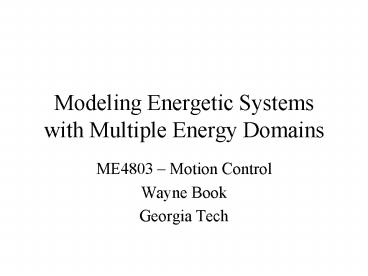Modeling Energetic Systems with Multiple Energy Domains - PowerPoint PPT Presentation
1 / 45
Title:
Modeling Energetic Systems with Multiple Energy Domains
Description:
Common Features. Product of effort (e) and flow (f) define power (P) ... Sign of positive energy flow. Component symbol (resistance) Causal stroke ... – PowerPoint PPT presentation
Number of Views:83
Avg rating:3.0/5.0
Title: Modeling Energetic Systems with Multiple Energy Domains
1
Modeling Energetic Systems with Multiple Energy
Domains
- ME4803 Motion Control
- Wayne Book
- Georgia Tech
2
Energy DomainsCommon Features
- Product of effort (e) and flow (f) define power
(P) - Mechanical e force f velocity
- Fluid e pressure f volumetric flow
- Electrical e emf (voltage) f current
- Magnetic e magnetomotive force (Ni) f
d(flux)/dt - Integral of flow is displacement q
- Integral of effort is momentum p
- Integral of power is energy E
3
The Tetrahedron of StateGeneral Case
4
Tetrahedron for Mechanical Systems
Force, N
Displacement, m
momentum
Velocity, m/s
5
Tetrahedron for Fluid Systems
6
Tetrahedron for Electrical Systems
7
Linkages between other vertices?
capacitance
Force displacement/compliance
resistance
Force damping x velocity
inertia
Momentum mass x velocity
8
Representation of Energy Ports(Bond Graphs)
Energy port
Effort variable
e1
Sign of positive energy flow
Other components in system
R1
f1
Causal stroke
Flow variable
Component symbol (resistance)
9
Resistive Elements in 4 Domains Dissipates
energy a static function between e and f
10
For Capacitor, q static function(e)
11
The Capacitor Stores Energy by displacement
12
Capacitive Elements in 4 Domains
13
The InertanceStores energy by momentum
14
For Inertia, f static function(p)
15
Inertance Elements in Four Domains
16
What 2-ports Look Like
17
What 3-ports Look Like
18
Conservation principles in Bond Graphs
Single effort
Single flow
19
Causality Distinguishes Inputs from
Outputs(independent from dependent, cause from
effect)
The causal stroke is by the component which
specifies the flow
The component on the other end specifies the
effort
20
More Causal Possibilities and the transformer
and gyrator concepts
21
Energy Ports are Demanded by Bond Graphs, but
Block Diagrams will Accomodate
22
Using Bond Graphs(and other energy port
representations)
- Derive equations of motion
- Identify components
- Construct graph (connections and conservation)
- Simplify
- Assign sign conventions (half arrows)
- Determine causality (causal strokes)
- Identify causality issues (differential causality
indicates algebraic constraints) - Examine for state variables (system order) and
causality conflicts - Simulate
- Note that 1c) through 3 can be done automatically
by computer (Dymola, Enport)
23
Simple Electrical Graph Example
24
More Complex Electrical Example
25
Rules for Connections (T Mech)
- Establish 1 junction for each relevant, distinct
velocity (absolute or relative) - Velocity sources impose velocity constraints
(including velocity 0) - Insert springs and damping between relevant 1
junctions by connecting through 0 junction. - Force sources attach to 1 junctions
- Attach inertias to 1 junctions (which sum forces)
- Eliminate zero velocity 1 junctions and bonds
- Any 0 or 1 junctions with only two bonds are
replaced by a single bond
26
Simple Mechanical (Translation)
27
More Complex Mechanical (Translation)
28
Hydraulic Graph Construction
- Establish 0 junction for each relevant pressure
- Attach components to 1 junctions placed between
appropriate 0 junctions - Assign sign conventions to power
- Define reference pressure and eliminate that
pressure 0 junction and associated bonds - Simplify 0 or 1 junctions with only 2 bonds
29
Simple Hydraulic
30
More Complex Hydraulic
31
Formulation of Equations from Bond Graphs
- ME4803-Motion Control
- Wayne Book
32
Formulation of System Equations
- Equations for same system (say 4th order) can be
in different forms - one 4th order equation
- two, second order equations
- four, first order equations dx/dt f(x, u)
- First order equations are most versatile for
simulation, analysis (linear and nonlinear) - Choice of variables affects ease in deriving
equations
33
To remember the nomenclature
- F(1)ow is constant
- Eff(0)rt is constant
- Sign half arrow shows positive energy flow e f gt 0
34
Causality Indications (review)Order of
Assignment of Causal Strokeindicating input of
effort
35
Three Cases of Causality
- Basic equation formulation when causality of
all bonds is determined by imposing - source as input constraint
- Integral causality constraint (storage elements)
- Consequences of 0-, 1-junctions and TF, GY
- Extended formulation I -- causality of some bonds
remains undetermined after above steps - Extended formulation II -- derivative causality
of some storage elements results (effort input to
C, flow input to I)
36
Example 1
37
Assignment of Causality Example 1
38
Example 2
39
Assignment of CausalityExample 2
40
Basic Formulation of Equations
- Identify
- bonds
- source variables
- energy variable derivatives for storage elements
- coenergy variables
- Write constitutive equations for storage elements
- Use structure and causality to eliminate coenergy
variables
41
Basic Formulation (cont.)
- Identify variables
- Write constitutive equations for storage elements
- Use structure and causality to eliminate coenergy
variables - express energy variable derivatives in junction
variables - replace coenergy variables until only inputs and
energy variables remain - The results are the state equations
42
Case 2 Incomplete causality results
43
Extended Formulaton ICausality Incompletely
Specified
Pick one R for effort in
Example with remaining acausal bonds
Each arbitrary selection that is necessary means
at least one algebraic equation to eliminate
intermediate variable in favor of state variables
Or pick for flow in
44
Case 3 Conflict in integral causality
45
Extended Formulation IIDerivative Causality of
Some Element
Assign causality for source (no propagation)
Assign causality for one C
Propagates to R
Propagates to other C
Results in differential Causality































